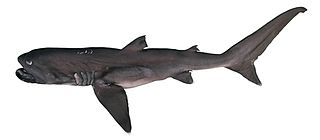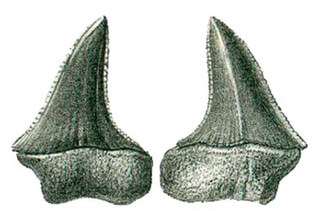
The megamouth shark is a species of deepwater shark. Rarely seen by humans, it measures around 5.2 m (17 ft) long and is the smallest of the three extant filter-feeding sharks alongside the relatively larger whale shark and basking shark. Since its discovery in 1976, fewer than 100 specimens have been observed or caught. Like the other two planktivorous sharks, it swims with its mouth wide open, filtering water for plankton and jellyfish. It is recognizable from its large head with rubbery lips. The megamouth is so unlike any other type of shark that it is usually considered to be the sole extant species in the family Megachasmidae, though some scientists have suggested it may belong in the family Cetorhinidae.

The Lamniformes are an order of sharks commonly known as mackerel sharks. It includes some of the most familiar species of sharks, such as the great white, as well as more unusual representatives, such as the goblin shark and megamouth shark.

Carcharodon is a genus of sharks within the family Lamnidae, colloquially called the "white sharks." The only extant member is the great white shark. The extant species was preceded by a number of fossil (extinct) species including C. hubbelli and C. hastalis. The first appearance of the genus may have been as early as the Early Miocene or Late Oligocene.

Otodus megalodon, commonly known as megalodon, is an extinct species of giant mackerel shark that lived approximately 23 to 3.6 million years ago (Mya), from the Early Miocene to the Pliocene epochs. O. megalodon was formerly thought to be a member of the family Lamnidae and a close relative of the great white shark, but has been reclassified into the extinct family Otodontidae, which diverged from the great white shark during the Early Cretaceous.

Cretoxyrhina is an extinct genus of large mackerel shark that lived about 107 to 73 million years ago during the late Albian to late Campanian of the Late Cretaceous. The type species, C. mantelli, is more commonly referred to as the Ginsu shark, first popularized in reference to the Ginsu knife, as its theoretical feeding mechanism is often compared with the "slicing and dicing" when one uses the knife. Cretoxyrhina is traditionally classified as the likely sole member of the family Cretoxyrhinidae but other taxonomic placements have been proposed, such as within the Alopiidae and Lamnidae.

Megachasma is a genus of mackerel sharks. It is usually considered to be the sole genus in the distinct family Megachasmidae, though suggestion has been made that it may belong in the family Cetorhinidae, of which the basking shark is currently the sole extant member. Megachasma is known from a single living species, Megachasma pelagios.

Otodus is an extinct, cosmopolitan genus of mackerel shark which lived from the Paleocene to the Pliocene epoch. The name Otodus comes from Ancient Greek ὠτ- and ὀδούς – thus, "ear-shaped tooth".

Otodus angustidens is a species of prehistoric megatoothed sharks in the genus Otodus, which lived during the Oligocene and Miocene epochs about 33 to 22 million years ago. The largest individuals were about 11–12 metres (36–39 ft) long. This shark is related to another extinct megatoothed shark, Otodus megalodon.

Otodus chubutensis, meaning "ear-shaped tooth of Chubut", from Ancient Greek ὠτ and ὀδούς – thus, "ear-shaped tooth", is an extinct species of prehistoric megatoothed sharks in the genus Otodus, that lived during Early Miocene to Middle Miocene. The largest individuals were about 13.5 metres (44 ft) long. This shark is considered a close relative of the famous prehistoric megatoothed shark O. megalodon. However, as is the case with O. megalodon, the classification of this species is disputed.

Hemipristis serra is an extinct species of weasel shark which existed during the Miocene epoch. It was described by Louis Agassiz in 1843. While today's snaggletooth shark is not very large or dangerous, Hemipristis serra, which lived in the Atlantic Ocean during the Oligocene and Miocene, was considerably larger than its modern-day relative and had much larger teeth. Its total length is estimated to be 6 metres (20 ft). Marks made by the teeth of H. serra are often found on the bones of the dugong Metaxytherium leading some scientists to hypothesize that H. serra specialized in preying on these sirenians. In the Gatun Formation of Panama, H. serra was contemporary with pups of the large lamniform shark Otodus megalodon, and both it and the great hammerhead are theorized to have preyed on the pups of this larger shark due to their presence within the formation.
The Yaquina Formation is a geologic formation in Oregon. It preserves fossils dating back to the Paleogene period.
The Jewett Sand Formation is a geologic formation in California, USA. It preserves fossils dating back to the Miocene Epoch of the Neogene period.

Cosmopolitodus is an extinct genus of mackerel shark that lived between thirty and one million years ago during the late Oligocene to the Early Pleistocene epochs. Its type species is Cosmopolitodus hastalis, the broad-tooth mako. In 2021, Isurus planus was reassigned to the genus, and thus became the second species C. planus. However, some researchers still consider both species of Cosmopolitodus as species of Carcharodon.

Parotodus, commonly known as the false-toothed mako shark, is an extinct genus of mackerel shark that lived approximately 53 to one million years ago during the Eocene and Pleistocene epochs. Its teeth, which are found worldwide, are often prized by fossil collectors due to their rarity. The scarcity of fossils is because Parotodus likely primarily inhabited open oceans far away from the continents.
Pseudomegachasma is an extinct genus of filter-feeding shark that was closely related to the modern sand tiger shark. It is known from Cretaceous strata in Russia and the United States, and is the only known planktivorous odontaspid, as well as the oldest known planktivorous elasmobranch. It most likely derived from its closest relative, the piscivorous shark Johnlongia. As its name suggests, it was originally classified under Megachasma, before it was found to be an odontaspid.

Carcharomodus escheri, commonly nicknamed the serrated mako shark or Escher's mako shark, is an extinct lamnid that lived during the Miocene. It has been formerly thought to have been the transitional between the broad-toothed "mako" Cosmopolitodus hastalis and the modern great white, but is now considered to be an evolutionary dead-end with the discovery of Carcharodon hubbelli. Fossil examples have been found along northern Atlantic coastlines and in parts of Western and Central Europe.
Megachasma alisonae is an extinct species of megamouth shark that lived during the Eocene. It is the oldest fossil record of a megamouth shark. The type fossil was recovered from the Søvind Marl Formation in Denmark and consists of a single tooth. Based on comparison with the teeth of the recent megamouth species, the length of the animal has been estimated at 1.3–3.5 m (4.3–11.5 ft).

Cretodus is an extinct genus of large mackerel sharks belonging to the proposed family Pseudoscapanorhynchidae. Cretodus lived during the Late Cretaceous, ranging from the Cenomanian to the Coniacian. The genus is well-known from strata deposited in the Western Interior Seaway, and from the Late Cretaceous of Europe, Africa, and possibly Asia. Cretodus is primarily represented in the fossil record by isolated teeth and vertebral centra, though a couple of associated dentitions and vertebral columns have been found.
Keasius is an extinct genus of basking sharks that lived during the Cenozoic. It contains four valid species, which have been found in North America, Europe, and Antarctica.
This list of fossil fish research presented in 2023 is a list of new taxa of jawless vertebrates, placoderms, acanthodians, fossil cartilaginous fishes, bony fishes, and other fishes that were described during the year, as well as other significant discoveries and events related to paleoichthyology that occurred in 2023.













